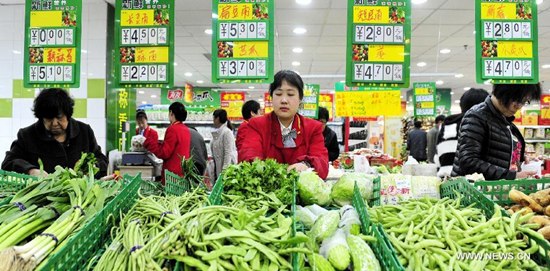
A staff member places vegetables at a supermarket in Cangzhou, capital of north China's Hebei Province, April 9, 2015. China's consumer price index (CPI), a major gauge of inflation, rose 1.4 percent from a year earlier in March, according to the data released by the National Bureau of Statistics on Friday. (Xinhua/Mou Yu)
Despite stabilizing consumer inflation and narrowed producer deflation in March, the world's second largest economy may need further loosening measures, economists said.
China's consumer price index (CPI), the main gauge of inflation, grew 1.4 percent year on year in March, the National Bureau of Statistics (NBS) said on Friday. The reading remained the same as in February, when it rebounded from January's 5-year low of 0.8 percent.
The CPI reading beat market expectations, and the drop in the producer price index (PPI), a measure of costs for goods at the factory gate, also narrowed from February's 4.8-percent decline to 4.6 percent.
The readings came as a relief to China's economy, which is experiencing a slowdown from its previous double-digit growth amid persistent deflationary pressure.
Producer prices have slid for the 37th straight month. The PPI started a downward trend in March 2012 and has yet to turn around. The 4.8-percent decline was its largest drop since 2012.
On a monthly basis, consumer prices in March edged down 0.5 percent from February, and producer prices contracted 0.1 percent, narrowing from a 0.7-percent decline in February.
NBS statistician Yu Qiumei attributed the monthly consumer price drop to declining prices after the Chinese Lunar New Year holiday.
Food demand retreated after the holiday, vegetables are in rich supply due to seasonal factors and prices of services dropped as many workers returned to their jobs after the holiday, Yu said.
The narrowing producer price drop can be mainly attributed to declines in oil and natural gas prices which declined by 15.7 percent month on month in February but increased 5.4 percent in March, according to Yu.
Despite stabilizing inflation in general, economists said deflationary risks remain due to the continuous plunge in factory gate prices and low consumer prices, which might presage more monetary easing policies in the coming months.
As March CPI was "in line with our forecast," and PPI came in better than expected, adding that the data show few signs of new inflationary pressure, Julia Wang, Greater China Economist of HSBC, said in a note.
However, the CPI in the first quarter averaged 1.2 percent, the lowest since the fourth quarter of 2009. "We maintain our call for more monetary easing in the coming weeks," Wang said.
"We expect the deflationary pressure in consumer prices to persist due to weak overall demand, despite the stabilization in global commodity prices," said Bob Liu, an analyst at the China International Capital Corp.
"We expect further loosening measures in the near future, which aim at boosting domestic demand and combating deflationary risk," Liu added.
To bolster the lukewarm economy, which expanded 7.4 percent in 2014, marking a 24-year low, the central bank has cut benchmark interest rates twice and banks' reserve requirement ratios once since November.
The wave of easing measures has prompted speculation that China's monetary policy has turned from "prudent" to "loose."
However, the central bank said last Friday that it will continue to implement a prudent monetary policy, balancing the need for economic controls against the need for liberalization.
After the quarterly meeting of China's monetary policy committee, the central bank said the complexity of China's current economic and financial operations should not be underestimated.
While stressing the need to keep policy prudent, the central bank said it will try to strike a balance between being too tight and too loose and resort to multiple monetary policy tools.
As the economy has yet to show convincing signs of improvement amid deflationary pressure -- as indicated by the weak manufacturing index -- expectations are high for further monetary easing measures.
At the 2015 Boao Forum for Asia (BFA) on March 29, central bank governor Zhou Xiaochuan said, "We must remain prudent and alert in assessing whether the inflation trend will continue and whether deflation will occur."
















































